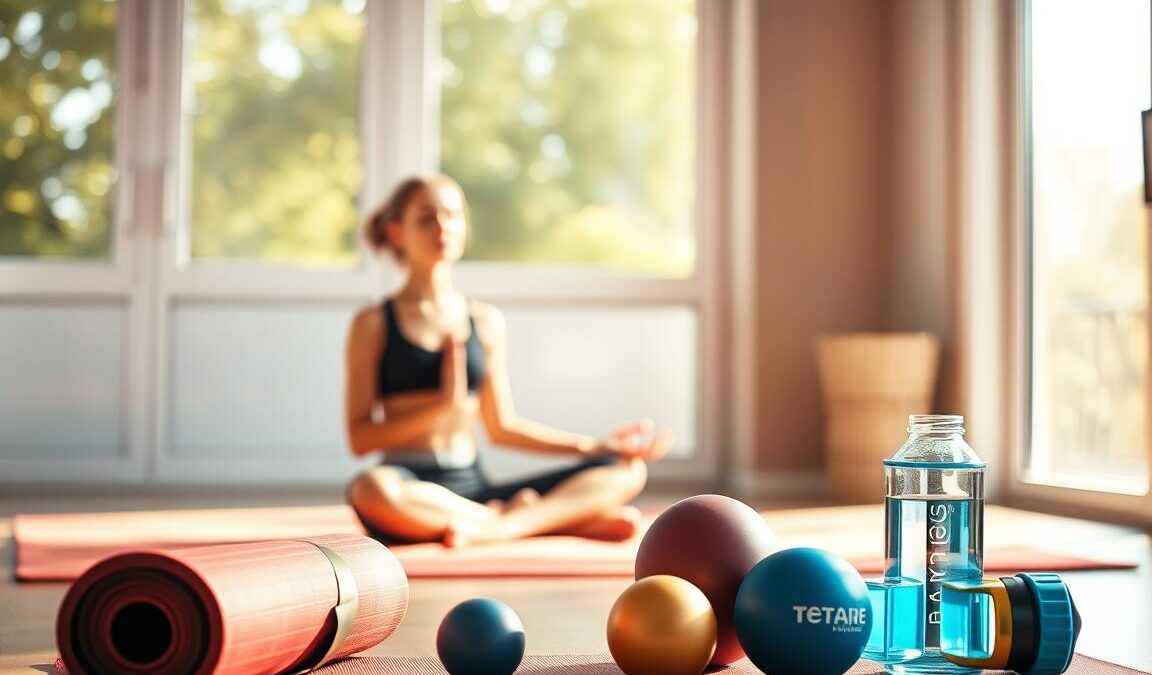
Mindful Recovery Practices to Speed Up Post-Workout Healing
The phrase mindful recovery after training matters because it turns your effort into real progress, not just sweat on the floor. When you view recovery as work, you protect your health, cut fatigue, and make results more predictable.
Start small: a five-minute cool-down boosts blood flow and eases stiffness. Rehydrate with electrolytes — coconut water, citrus, or a pinch of sea salt — and pair protein with complex carbs within an hour to help muscle repair and restore energy.
Move gently through tight spots with foam rolling or slow massage, breathing through tender areas. Sleep seven to eight hours to support repair and balance the nervous system. These simple steps become a reliable routine that protects performance and keeps your motivation steady.
Key Takeaways
- Recovery is part of the work: it converts effort into progress.
- Commit to a five-minute cool-down to reduce stiffness and speed healing.
- Rehydrate with electrolytes and eat protein plus carbs within an hour.
- Use foam rolling or gentle massage and breathe through tight areas.
- Prioritize 7–8 hours of sleep to support repair and better sleep quality.
Why slowing down after workouts builds strength, resilience, and better results
Give the clock and the process some respect. Micro-tears form in muscle fibers during exercise. Those tears trigger a repair window where blood delivers nutrients and building blocks that make you stronger.
The body’s repair window: muscle micro-tears, blood flow, and the role of time
Strength gains happen between sessions, not during them. A short, five-minute cool-down boosts circulation so waste clears and fresh blood reaches working tissue. That small step changes how you feel in the next 24–48 hours and lowers the rate of lingering soreness.
Mind-body connection: how attention lowers stress and supports sustainable performance
Your nervous system needs downshifting as much as your muscles. Simple attention to breath and body sensations lowers stress and keeps performance steady across workouts and competition.
- Spot the difference between normal training stress and overload; check in early.
- Track how quickly energy returns and the quality of movement the next day.
- If pain or swelling lasts more than two or three days, seek professional advice.
Mindful recovery after training
You don’t need a long cooldown—just a few clear steps done the same way every time. Start with a short, repeatable ritual that resets your body and calms your head. Do it right after your session and again before bed to get the most benefit.
A quick post-session ritual: cool-down, breath, rehydrate
Spend five minutes walking or easy mobility to keep blood moving. Follow with two minutes of light foam rolling on calves, quads, glutes, and upper back. Move slowly and breathe through tender spots rather than pressing hard.
Rehydrate with water and simple electrolytes — coconut water, citrus, or a pinch of sea salt. Finish the sequence with one minute of nasal breathing to drop heart rate and set the nervous system toward rest.
Two places to practice: right after your session and before sleep
Do a 2–4 minute body scan immediately after workouts. Note tension hotspots, breath depth, and mood. That intel helps you adjust tomorrow’s plan and limits lingering fatigue.
Practice the same short scan before sleep to let go of competition thoughts and reduce stress. The twin windows—post-session and pre-sleep—make this routine simple and automatic.
- Short and consistent: 2 min walk, 2 min mobility, 1 min nasal breathing.
- Hydrate smart: water + electrolytes to restore balance.
- Self-check: pay attention to tension and sleep quality to guide your next workout.
| Step | Time | What to do | Immediate benefit |
|---|---|---|---|
| Cool-down walk | 2 minutes | Easy pace, swing arms, steady breath | Lower heart rate, better circulation |
| Mobility / foam roll | 2 minutes | Slow passes on major muscle groups | Ease tight spots, reduce soreness |
| Nasal breathing | 1 minute | Slow inhales and exhales through the nose | Calms nervous system, reduces stress |
| Pre-sleep body scan | 2–4 minutes | Head-to-toe attention, soft breathing | Faster sleep onset, less mental fatigue |
A step-by-step cool-down you can do in five minutes
Use a tight 5-minute plan to drop heart rate, move blood, and calm the nervous system. Do this anywhere—gym, park, or at home—so the benefits stick and fatigue eases before it settles in.
Walk it down: easing heart rate and improving circulation
Minute 0–2: Walk at an easy pace and breathe through your nose. Add gentle arm swings and ankle circles to nudge circulation in joints used during the session.
Mobility and light stretching: releasing tension before stiffness sets in
Minute 2–3: Do 20–30 seconds each of calf rocks, quad pulls, and hip openers. Keep motion smooth; you’re sending “all clear” signals to the nervous system.
Minute 3–4: Run thoracic rotations and shoulder CARs (controlled articular rotations) to restore upper-back and shoulder mobility after pressing or pulling.
Minute 4–5: Settle into a tall kneel or half-kneel and take six slow breaths (4-count inhale, 6–8-count exhale). This breathing pattern lowers stress and helps muscles relax.
- Keep stretches light—aim to release tension, not chase extreme range while tissues are warm.
- If legs feel heavy, add 30–60 seconds of easy cycling or marching in place to aid blood return.
- For competition days, extend the walk to five minutes to bring your system down more smoothly.
- Note one tight area and give it an extra 30 seconds post-cool-down; small, targeted work pays off.
For mobility drills and simple techniques to add on rest days, see this short mobility guide: crossfit mobility exercises.
| Step | Time | Benefit |
|---|---|---|
| Easy walk + arm swings | 0–2 minutes | Gradual heart rate drop; better blood flow |
| Calf/quad/hip moves | 2–3 minutes | Release tension; reduce next-day stiffness |
| Thoracic rotations + shoulder CARs | 3–4 minutes | Restore upper mobility; ease shoulder stress |
| Breath reset | 4–5 minutes | Lower stress; shift body toward recovery |
Breathing and meditation techniques that calm your nervous system fast
Short breathing drills and a brief body scan help your nervous system shift fast and clear mental noise. These techniques give quick relaxation and improve focus so you move better the next day.
Body scan meditation: a 6–10 minute script to reset body and mind
Lie on your back and close your eyes. Notice contact points at your feet. Move attention slowly up the legs, hips, torso, arms, neck, and head.
Spend a few breaths on each area. If the mind wanders, label the thought and return your attention without judgment. Finish by resting on the rise and fall of the breath for a minute.
Fast benefit: lowers mental stress and eases racing thoughts before sleep or on a rest day.
Breath focus for recovery: 4-7-8 and slow nasal breathing to lower heart rate
Use 4-7-8 when you need a quick reset: inhale 4, hold 7, exhale 8 through the mouth. Repeat 4–6 rounds. You’ll feel the heart rate dip and tension drop.
For walk-downs, breathe only through your nose for 2–3 minutes at an easy pace. Nasal breathing slows breath and helps the system shift toward calm.
Visualization for healing: cueing relaxation and muscle repair
Picture warm blood and gentle repair at a sore spot. Imagine moving easily in tomorrow’s workout. Keep images simple and positive.
Why it works: athletes in controlled groups show less mental fatigue with mindfulness-based practice. These scripts target the mind and cut mental load even when physical fatigue stays the same.
- Try a timed 6–10 minute body scan before bed.
- Use 4–7–8 after intense sessions.
- Do nasal breathing during your cool-down walk.
| Technique | Time | Best use |
|---|---|---|
| Body scan | 6–10 minutes | Pre-sleep, mental reset |
| 4-7-8 breathing | 2–4 minutes | Quick reset after intense efforts |
| Nasal breathing | 2–3 minutes | Finish workouts; lower heart rate |
Sleep optimization: the most powerful recovery tool you’re not maximizing
Good sleep is where growth hormone does its best work and your movement patterns get wired in. Aim for seven to eight hours most nights to support muscle repair and skill consolidation.
Sleep quality essentials: dark, cool, quiet, and consistent timing
Set your bedroom cool and blackout the light. Small fixes—fan for white noise, blackout curtains—lift sleep quality fast.
Go to bed and wake up within a 60–90 minute window each day so your system learns when to shut down.
Pre-bed wind-down: gentle stretches, screen limits, and mindfulness cues
Build a 10–15 minute routine: light stretches for tight spots, screens off an hour before lights out, and three slow breaths or a brief body scan.
If late workouts leave you wired, add 4–5 minutes of nasal breathing in the last hour to drop stress and heart rate.
Smart tracking: using wearables for trends without obsessing over numbers
Use devices like Apple Watch or Fitbit to spot patterns in total sleep and stage time. Look for trends, not perfect nightly scores.
Track how your energy rate rebounds after hard workouts and adjust caffeine or wind-down time to protect results.
- Treat sleep as a cornerstone: it restores the nervous system and locks in adaptations.
- Defend seven hours: on busy weeks protect minimum sleep even if volume dips.
- Use data wisely: let wearables guide habits, not judge a single night.
| Focus | Action | Quick benefit |
|---|---|---|
| Environment | Cool (60–67°F), dark, quiet | Improves sleep quality and deep sleep rate |
| Pre-bed routine | 10–15 minutes: stretches, screens off, 3 breaths | Faster sleep onset; lower stress |
| Wearables | Track weekly trends, not nightly scores | Data-driven habit changes; better long-term results |
| Timing | Same 60–90 minute bed/wake window | Stronger circadian signal; steadier performance |
Recovery nutrition made simple: what to eat and when
A clear, simple post-workout plate beats guessing—pair protein with complex carbs and you’re set.

The protein + complex carb pairing window for muscles and energy
Aim to eat within about an hour of exercise. Focus on roughly 20–30g of protein plus a source of complex carbs.
That combo helps muscles repair and refills energy stores for your next session.
Micronutrients that matter: magnesium, antioxidants, and daily greens
Add magnesium-rich foods like spinach, avocado, and pumpkin seeds to help muscles relax and lower stress.
Pack antioxidants from berries, citrus, or bell peppers to support normal inflammation and overall health.
If you struggle to get greens, a reputable greens powder can fill gaps. Use it as a booster—not a food swap.
Quick ideas for busy days
- Greek yogurt + berries + nuts — fast, high-protein, nutrient-dense.
- Salmon over leafy greens — omega-3s, protein, and magnesium-rich sides.
- Whole-grain toast + nut butter + banana — simple carbs and sustained fuel.
Hydrate steadily and add electrolytes when you sweat a lot. Simple prep—batch-cook proteins and wash produce—makes good choices automatic.
| Goal | What to eat | When | Quick benefit |
|---|---|---|---|
| Refuel & repair | 20–30g protein + whole-grain carbs | Within 60 minutes | Supports muscles and restores energy |
| Micronutrient support | Spinach, avocado, berries | Daily | Magnesium and antioxidants for health |
| Convenience | Greens powder + yogurt or shake | When short on time | Fills nutrient gaps; not a replacement |
If you want tailored results, consult a sports nutritionist—especially athletes with high volume work. Track how meals make you feel the next morning and pick the combos that leave you energized and ready to go. These small techniques add up.
Active recovery, mobility, and self-massage for daily relief
Keep one rest day active with gentle motion that boosts circulation but doesn’t tax you. Short, easy movement keeps tissues fed and lets your body repair while you stay fresh.
Light movement on rest days
Plan 20–30 minutes of walking, light cycling, or a mobility flow. The aim is circulation, not sweat—think steady pace and relaxed breathing.
Sprinkle mini-mobility breaks if you sit a lot: neck nods, shoulder rolls, and hip openers. These micro-pauses stop stiffness from building through the day.
Foam rolling basics
Use slow passes for 20–30 seconds per spot: calves, quads, hamstrings, glutes, and lats. Keep the roll steady and deliberate. Skip fast bouncing or pressing hard.
Breathe through tender areas. If something is intense, pause and take three slow exhales, then resume. That simple cue helps tissues let go without causing more irritation.
- Cap the session at 10–15 minutes—feel looser, not wiped out.
- Hydrate throughout the day to support tissue quality and ease mobility work.
- Pair light movement with a calm playlist or nature time for extra relaxation.
- Notice how your body feels the next morning; good active work should lift performance, not drag it down.
| Focus | Time | Benefit |
|---|---|---|
| Easy movement | 20–30 minutes | Improved circulation; less stiffness |
| Foam rolling | 10–15 minutes total | Fascia flexibility; local comfort |
| Mini breaks | 1–2 minutes each | Prevents stiffness for desk-based days |
If any area stays sore more than two to three days, back off load next session and consider a targeted mobility or therapy visit. Small, consistent techniques keep your muscles ready and protect long-term performance.
Stress management that protects performance and prevents burnout
Small, repeatable practices cut stress hormones fast and preserve the gains you worked for. Use short tools that fit your life and keep performance steady when time gets tight.
Short practices with big payoff: yoga, journaling, and nature walks
Ten minutes of gentle yoga, a quick journal brain-dump, or a quiet nature walk lowers stress and helps sleep. These moves reduce cortisol, calm the mind, and speed recovery.
Pick one and make it a routine: consistent micro-practices beat occasional long sessions. They also protect athletes and weekend warriors from piling up fatigue.
Positive self-talk and goal check-ins: staying motivated through plateaus
Reframe setbacks with quick phrases: swap “I’m stuck” for “I’m adapting.” Look for the smallest next action to keep motivation alive.
- Check goals monthly and adjust loads to match real life.
- If fatigue or mood flags persist, reduce volume 10–20% for a week.
- Ask a friend or coach for brief accountability when progress stalls.
| Signal | Action | Benefit |
|---|---|---|
| Poor sleep | Evening breath work, earlier lights-out | Better sleep and energy |
| Low motivation | Short goal reset, micro-task | Faster momentum |
| Chronic fatigue | Cut volume 10–20% | Prevents burnout; protects performance |
Tools, topicals, and data: when to use extras and how to choose wisely
Not every gadget or cream speeds healing—some just change how you feel in the moment. Use extras to add comfort and useful information, not to hide problems. Pick items that match the area and the issue you face.

Topical comfort options
For large muscles, a spray gives fast, even coverage and instant relief for quads, back, or calves. For small spots, a roll-on lets you target neck, forearms, or shoulders without waste.
Understanding ingredients
Cooling or warming actives like menthol create a sensation that eases discomfort. NSAID topicals (diclofenac) address inflammation directly. That difference matters when you want symptom relief versus reducing swelling.
Monitoring signals and using data
Track simple signals: RPE, soreness location and duration, and whether light movement eases pain. Use wearable data as trend lines, not final verdicts. Groups of sessions tell you the real picture.
- Apply topicals only on clean, cool skin; avoid broken skin.
- Keep your kit small for competition: one topical, a roller, and clear rules.
- Consult a clinician if pain limits range or worsens with easy activity.
| Tool | Best use | What it does | Quick takeaway |
|---|---|---|---|
| Pain relief spray | Back, quads, calves | Even coverage; fast sensory relief | Good for broad-area relief |
| Roll-on | Neck, shoulders, forearms | Targeted relief; low product waste | Use for precise discomfort |
| Menthol topical | Surface soreness | Cooling/warming sensation | Feels like circulation; symptom relief |
| Diclofenac gel | Inflamed areas | Anti-inflammatory action | Addresses inflammation, not just feeling |
Final note: Tools play a supporting role. Give most attention to sleep, nutrition, and smart load management. Use data and these extras to protect performance and limit fatigue, not to replace core habits.
Conclusion
Wrap your plan with a few reliable habits that protect performance and make results predictable.
Build your routine around three non-negotiables: a short cool-down, a protein-plus-complex-carb meal within an hour, and seven to eight hours of sleep. These steps cut fatigue and lift sports performance over time.
Use breath work and brief meditation to lower stress and sharpen focus before competition or hard sessions. Add light mobility on rest days, steady hydration, and small tools only once the basics are solid.
Check three signals weekly—sleep consistency, eagerness to exercise, and how your body feels on waking—to guide adjustments. Start with five minutes after a session and five before bed. Repeat it, and you’ll see better results by tomorrow morning.


